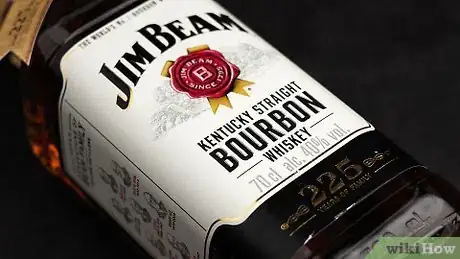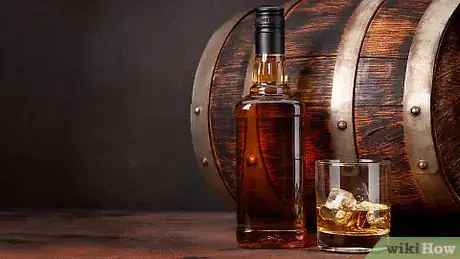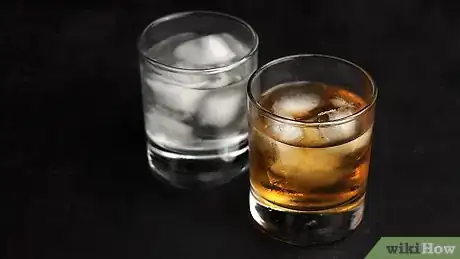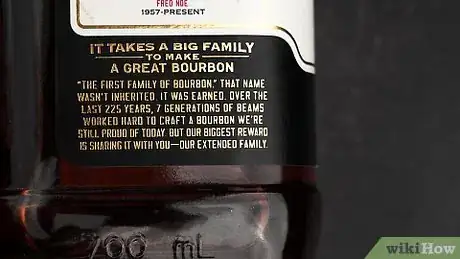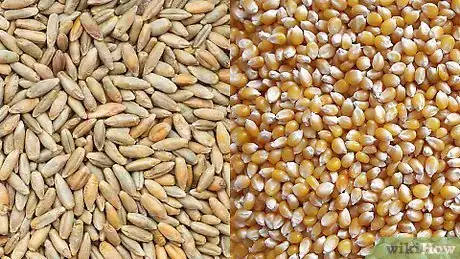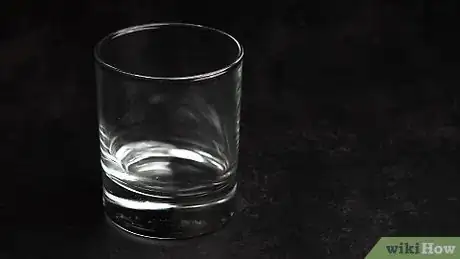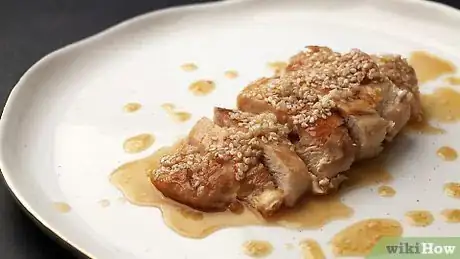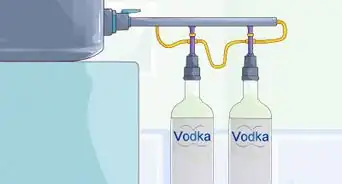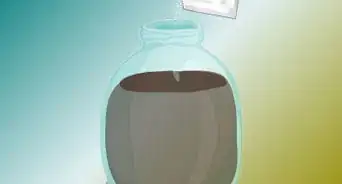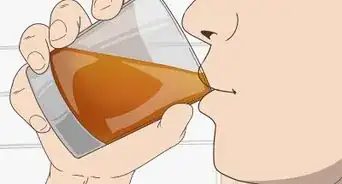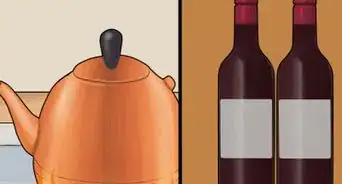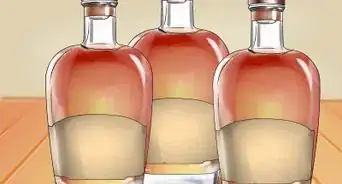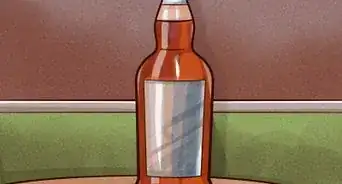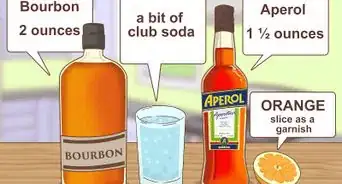This article was co-authored by Tom Blake. Tom Blake manages the bartending blog, craftybartending.com. He has been a bartender since 2012 and has written a book named The Bartender's Field Manual.
wikiHow marks an article as reader-approved once it receives enough positive feedback. In this case, several readers have written to tell us that this article was helpful to them, earning it our reader-approved status.
This article has been viewed 313,414 times.
Mark Twain famously said, "If I cannot drink bourbon and smoke cigars in heaven, I shall not go." This is the mindset of most bourbon lovers: without bourbon, where is the beauty in drinking? However, if you have never tasted bourbon and are unsure of how to drink it, then you have come to the right place. Bourbon is a type of American whiskey – a barrel-aged, distilled spirit made primarily from corn. Are you ready to start your journey through the art of drinking bourbon?
Steps
The Bourbon Basics
-
1Know the basic standards that each batch of bourbon must meet. Bourbon is a type of spirit that is "a distinctive product of the United States," according to U.S. federal law. In 1964, Congress issued federal standards regarding the production of bourbon. These standards include[1] :
- It must be made with no less than 51% corn.
- It must be aged in "new" charred oak barrels. "Straight" bourbon refers to bourbon that has been aged in these barrels for 2 years.
- It must be distilled to no more than 160 (U.S.) proof (80% alcohol by volume.)
- It must be entered into the barrel for aging at no more than 125 proof (62.5% alcohol by volume).
- It must be bottled (like other whiskeys) at 80 proof or more (40% alcohol by volume).
-
2Look for bourbons that have hit the right age. Bourbon has no minimum required age, but it is normally aged for 4-9 years. "Straight" bourbon is only aged for 2 years. As bourbon ages, it takes on a deeper brownish amber color, a richer flavor, and a slightly increased level of sweetness.
- Bourbon is aged in barrels, and during the extended aging process, normally 7-8 years, some of the bourbon will permeate through the wood of the barrel. This is called the "Angels' Share." There is also a certain amount absorbed into the char of the barrel. This is extracted and labeled the "Devil's Share." Jim Beam calls this the "Devil's Cut."
- The barrels used for aging the bourbon are never used again. Instead, they are used to age soy sauce and whiskey (for instance, scotch) or are made into beautiful pieces of furniture.
Advertisement -
3Recognize the different colors of bourbon. Most bourbons are amber and brown, while some varieties remain white (or clear). As a first-time bourbon drinker, you will want to start with a brown bourbon. The brown color of bourbon comes from the barrel "breathing" into and out of the char and wood of the barrel. The color comes from the char and the wood of the barrel. [2]
- White whiskey Bourbon is as clear as water. It is aged for 1 year and is called by several names, including "The Ghost," "Raw Whiskey," "White Dog Whiskey" (Jack Daniels), and "Jacob's Ghost" (Jim Beam), among others.
-
4Learn about the history of bourbon. The name Bourbon comes from the French Bourbon dynasty. Bourbon County, Kentucky, was named after this French royal family, and bourbon was first produced in the old Bourbon county region of Kentucky. Bourbon was originally made in the 18th century but didn't become well known until the 1860s. Due to re-definitions written into NAFTA, bourbon is now made throughout the United States.
- However, by tradition, true bourbon comes from distilleries located in the original 1786 Old Bourbon County region in northeastern Kentucky which has since been divided into 34 separate counties.
- The first distillery in present-day Bourbon County to be licensed since Prohibition did not begin operating until 2014. Whiskey makers of good reputation outside of the historic Bourbon County region will not use the term bourbon for their whiskeys.
-
5Know the different types of bourbon and their specific flavors. Most bourbons are made with corn, rye, and barley. More traditional bourbons contain 8 to 10% rye. However, bourbons can be divided into several additional categories, including High Rye, High Corn, and Wheated.[3]
- High Rye means that the bourbon is made up of more than 10% rye. Bourbons that have a high rye content are generally spicier than other bourbons and are known for their bold flavor. Common high rye bourbons include Bulleit, Old Grand Dad, and Basil Hayden.
- High Corn bourbons contain more than 51% corn. Bourbons with high corn content are often much sweeter than traditional bourbons. High corn bourbons include Old Charter and Baby Bourbon.
- Wheated bourbons are bourbons that substitute wheat for rye, making them a combination of corn, wheat, and barley. These bourbons are softer on the palate and have a stronger flavor of caramel or vanilla. Maker’s Mark, Van Winkle bourbons, and Rebel Yell are some of the more common wheated varieties.
Tasting Bourbon
-
1Buy several varieties and conduct a taste test. Select a traditional bourbon, a high rye bourbon, a high corn bourbon, and a wheated bourbon. Sample them all and choose the one that you like the best.
- You could also try a blend. A 4-year old blend is a bourbon for which the youngest whiskey used, not including neutral grain spirits, is aged 4 years. (Neutral grains are not whiskeys.)
-
2Get a glass suitable for liquors. Special glasses are not required, but some shapes do enhance the smelling and tasting experience. Glasses with wider mouths are better because they allow you to really smell the bourbon (they also make it easier to add ice if you want to). A richer smell will enhance the taste of the bourbon.
-
3Pour the bourbon into the glass. Pour a small amount and let it settle for several seconds. Before you taste it, smell the bourbon. Do this by sticking your nose over the edge of the glass and parting your lips on the edge of the glass. In this way, you will be both smelling and tasting at the same time.
- The smells of bourbon vary greatly from bottle to bottle, and of course they depend on each person's sense of smell. Some of the more common descriptions of bourbon aromas include old wood, vanilla, caramel, and matches.
-
4Take a sip of the bourbon. Let it roll across the tongue, and swallow it. Let your tongue "chew" on the flavor for a few seconds, and then breathe out through your nose and mouth together to get the full flavor. If you are not used to drinking liquor, be prepared for the "bite" the bourbon will give your mouth.
Mixing Bourbon
-
1Consult a bartender's recipe list for choices. Bourbons are sipped neat (alone), with water, on the rocks (with ice), or mixed into a cocktail. Indeed, bourbon has gained a great deal of popularity as a standard spirit used in cocktails.
-
2Try a bourbon-based cocktail. The Manhattan is probably the most famous of the bourbon-based cocktails. Don’t be shocked if you feel like a mobster while drinking this classic. Another cocktail is the Mint Julep. The Mint Julep is a delightfully refreshing staple cocktail often served in the southern United States.
- However, if you prefer basic cocktails to the fancier ones, look no further than the Bourbon and Coke. This pairing is easy to drink (and will save you money at bars).
-
3Use bourbon in the kitchen. Bourbon is not just used for drinking; it can also add a delicious flavor to your favorite dishes. Bourbon chicken is a classic dish that infuses the chicken with a delectable bourbon flavor. You could also try making a bourbon-infused brown sugar glaze that tastes fabulous on salmon.
Expert Q&A
Did you know you can get expert answers for this article?
Unlock expert answers by supporting wikiHow
-
QuestionHow does one make a mint julep?
 Tom BlakeTom Blake manages the bartending blog, craftybartending.com. He has been a bartender since 2012 and has written a book named The Bartender's Field Manual.
Tom BlakeTom Blake manages the bartending blog, craftybartending.com. He has been a bartender since 2012 and has written a book named The Bartender's Field Manual.
Professional Bartender
-
QuestionHow do you make a Manhattan?
 Tom BlakeTom Blake manages the bartending blog, craftybartending.com. He has been a bartender since 2012 and has written a book named The Bartender's Field Manual.
Tom BlakeTom Blake manages the bartending blog, craftybartending.com. He has been a bartender since 2012 and has written a book named The Bartender's Field Manual.
Professional Bartender
-
QuestionWhen do you serve bourbon to dinner guests?
 Community AnswerIt depends. On its own or in a classic cocktail, it works well as an aperitif. It also mixes well with sweeter, dessert-type ingredients and pairs well with certain foods. It is a versatile spirit, and it really dependson what you want to do with it.
Community AnswerIt depends. On its own or in a classic cocktail, it works well as an aperitif. It also mixes well with sweeter, dessert-type ingredients and pairs well with certain foods. It is a versatile spirit, and it really dependson what you want to do with it.
Warnings
- Always drink responsibly. Do not drink and drive. Keep track of how much you have had and know your limits.⧼thumbs_response⧽
References
About This Article
To drink bourbon, start by pouring it into a glass with a wide mouth so the glass is ¼ full. Let the bourbon settle for a few seconds, then put your mouth on the edge of the glass and your nose over it, so you can smell and taste it at the same time. Smell the bourbon as you take a sip, and let it roll across your tongue before you swallow it. Then, breathe out through your nose and mouth to get the full flavor. If you like how it tastes, keep drinking it “neat,” or alone. Alternatively, try it with a little water or on the “rocks,” which is over ice. For tips on how to pick a bourbon that’s appropriately aged, keep reading!
